Recent Articles
Popular Makes
Body Types
2020 Kia Stinger Road Test and Review

2020 Kia Stinger ・ Photo by Kia
Last year, Kia sold over 615,000 cars and crossovers in the United States, an increase of 4.4 percent over 2018. The majority of those sales were crossovers, led by the Kia Soul, Sorento, and Sportage. Its latest crossover, the seven-passenger Telluride, is also red-hot, selling faster than dealers can replenish their stock.
Unfortunately, the brand’s best sedan, the 2020 Kia Stinger, isn’t doing as well as it should. With its excellent rear-wheel drive platform, available all-wheel drive, powerful turbocharged engines, sexy good looks, and a luxurious interior, the Stinger is the brand’s highest-performance vehicle and has been one of our favorite sedans since it was introduced in 2018. Yet Kia has only sold about 37,000 in the last two-and-a-half years. This is a car more Americans should be buying. The 2020 Kia Stinger is fast, fun, and comfortable, and with prices starting in the mid-$30,000 range and topping out at about $54,000, it’s an incredible value compared to many of its European sport sedan rivals from BMW, Mercedes-Benz, and Audi.
Powerful Turbocharged Engines
Built in South Korea, the Stinger is available in four trim levels: GT-Line, GT, GT1, and GT2. Each is offered with rear-wheel drive, with all-wheel drive available for an additional $2,200. The GT-Line is powered by a 255-horsepower turbocharged 2.0-liter four-cylinder, while the other models get a 365-hp 3.3-liter twin-turbo V6. Both engines are backed by a smooth and responsive eight-speed automatic transmission with paddle shifters. Our test car was a rear-wheel drive Stinger GT, with a few optional extras and a sticker price of $40,915, including a $995 destination fee.
Kia is part of the same automaker as Genesis, and the Stinger shares its rear-wheel drive platform, engines, and other hardware with the Genesis G70, which debuted about a year ago to rave reviews. The Stinger’s wheelbase is a few inches longer than the G70’s, however, which gives it considerably more rear-seat legroom. It’s also about 6 inches longer overall, and the Kia is a hatchback while the Genesis has a traditional sedan trunk. These differences also give the Stinger considerably more cargo space.
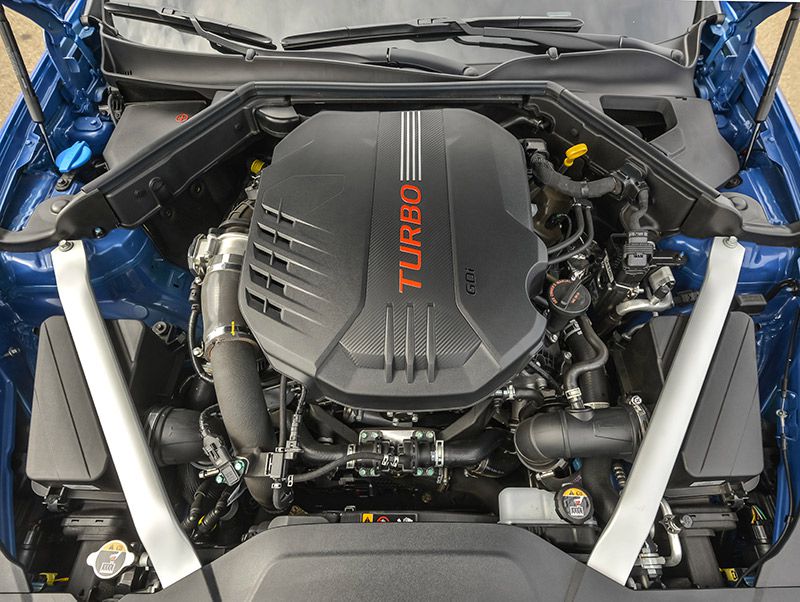
Photo by Kia
Attractive, Comfortable Interior
Inside, this is a luxurious car, but there’s nothing stuffy about its cabin. Open the door of the 2020 Kia Stinger and you’re met with quality materials, dynamic design, and a high level of build quality. The overall design is modern and sporty, but also simple. Kia doesn’t mess around with a trendy push-button shifter, and all of its knobs and switches are where you expect them to be.
Its controls don’t just look good, they feel good. Most wear small trim and they all function with precision. The shifter is perfectly placed and works with a satisfying heft, as do its door handles and the switch for its electronic parking brake. Our test car’s red leather seats and aluminum trim were a striking combination. Even the Kia’s key fob feels like a quality item, with a sleek design and a swatch of leather.
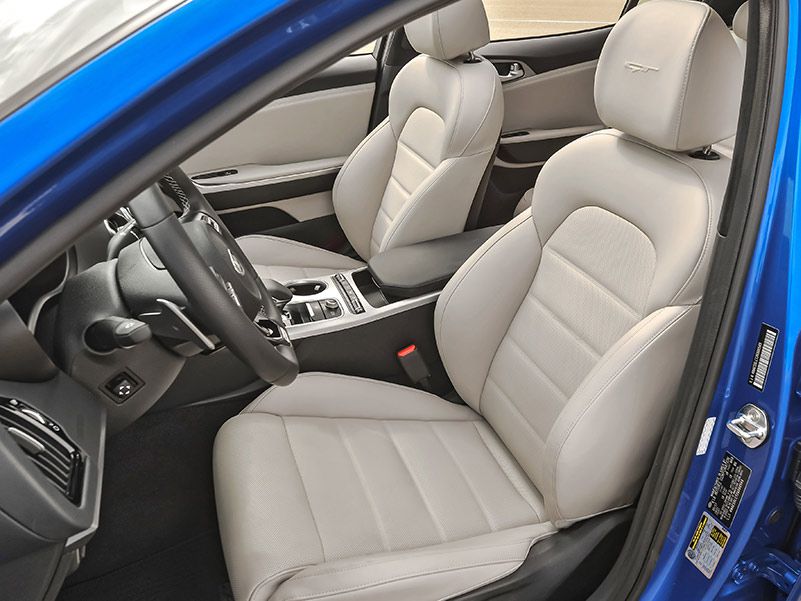
Photo by Kia
Packed With Comfort and Features
One of the best parts of the Kia Stinger’s interior are its seats. Firm and well-shaped, they’re extremely comfortable, with bolsters that hold you in place but don’t hug too tightly. It’s easy to find the perfect driving position, which is lower than you’ll find in some other sports sedans. Visibility is excellent in all directions.
Our test car featured heated front seats, dual-zone climate controls, power seats, a wireless phone charger, and keyless entry. Heated rear seats, ventilated front seats, a sunroof, and navigation are also available. The Kia’s 7-inch touchscreen is well-positioned and quick to respond, but small compared to others in this class. GT1 and GT2 models get an 8-inch screen, which should be the minimum these days as 10-inch units become increasingly common. Graphics are clean and modern, and Kia doesn’t bury any functions in a sea of confusing menus. It’s all very intuitive to use. Android Auto and Apple CarPlay are standard.
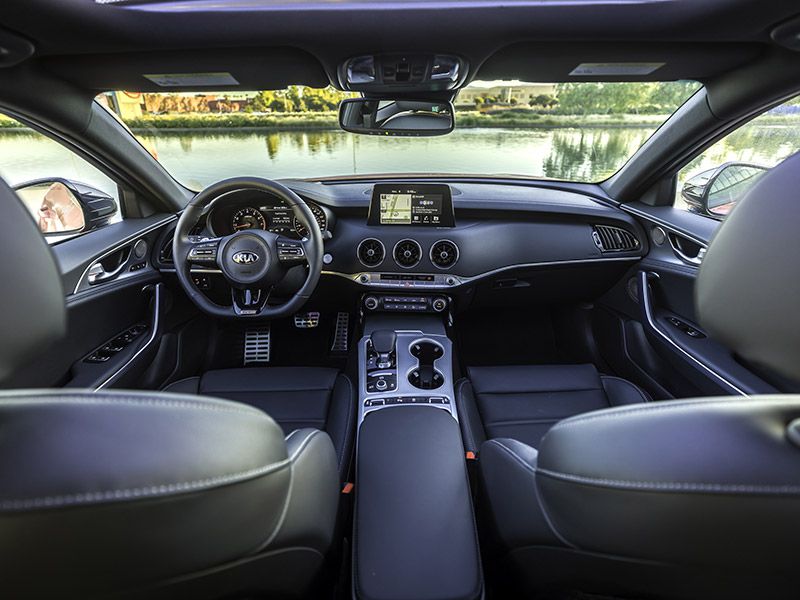
Photo by Kia
Family-Friendly Sedan
Interior storage is generous. The Kia’s center console bin is large, as are its door pockets, and the two front cupholders are deep and well-located. There’s also a big bin ahead of the shifter, which is perfect for your phone or wallet. Its 23.3 cubic feet of trunk space is also more than you get in a Porsche Panamera. If more is needed, every Stinger comes with a 60/40 split-folding rear seat, which drops easily to expand the space to 41 cubic feet. Its large hatch is also easy to open and close. A power-operated back hatch is only standard on top GT2 trim level.
The Stinger also offers more rear-seat room than many of its competitors, and three teens fit in the back without any issues. Two rear air-conditioning vents are standard. Younger parents still wresting with child safety seats will appreciate the Kia’s easy-to-reach LATCH connectors in the outboard seats.
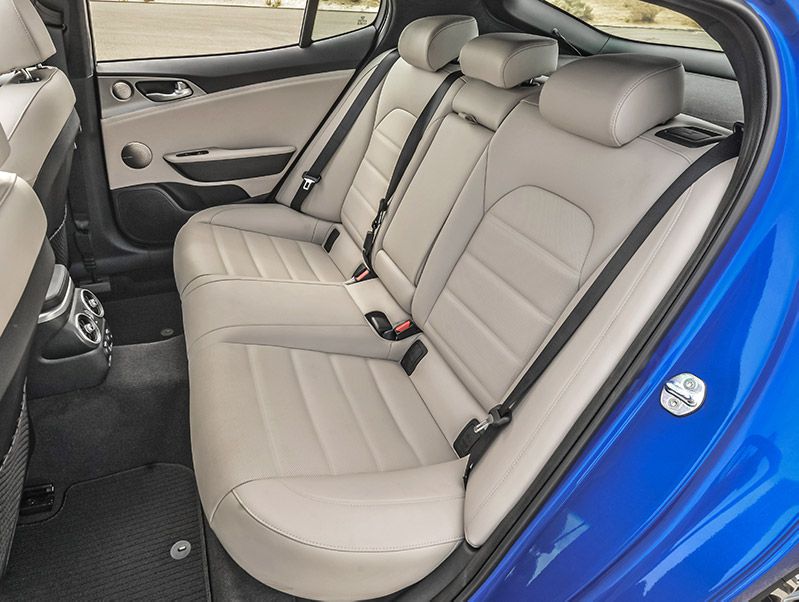
Photo by Kia
Fast, Fun, and Responsive
For most buyers, the Kia Stinger GT-Line’s 2.0-liter turbocharged 255-horsepower four-cylinder offers more than enough acceleration. The engine is smooth and refined and delivers plenty of performance, including a 0-60 mph time of about 6.0 seconds. That said, we prefer the Stinger’s big 3.3-liter twin-turbocharged V6, and its additional power is worth the increase in price.
With the V6 pumping out 360 horsepower and 376 lb-ft of torque, the 2020 Kia Stinger GT is a great performer. There’s serious punch off the line, and the engine is perfectly matched to the sedan’s eight-speed automatic, which shifts smoothly and precisely and always seems to be in the right gear. Put your foot down hard on the Kia’s gas pedal, and the acceleration pushes you back in the seat and holds you there until you lift your foot off the throttle. It builds speed quickly. This is a true sports sedan that’ll get your blood pumping. Use its launch control and it’ll hit 60 mph in about 5 seconds. That’s about as quick as an Audi A7.

Photo by Kia
Good Fuel Economy
The Kia’s fuel economy is also good for this class. With rear-wheel drive and the 2.0-liter engine, the Stinger is rated at 22 mpg in the city and 29 mpg on the highway. With all-wheel drive, which adds about 250 lbs to the car, that city number dips to 21 mpg.
With the twin-turbo V6 engine, the Stinger is rated at 17 mpg city and 25 mpg highway with rear-wheel drive or all-wheel drive. It features a start/stop system that shuts off the engine at idle to save fuel, and the system is smooth enough not to be a bother. For comparison, the Audi A7 is rated at 22 mpg city and 29 mpg highway. In mixed driving around Los Angeles, we averaged 21.8 mpg in the Stinger GT. On the upside, its big V6 runs on less expensive regular-grade gasoline to cut operating costs.
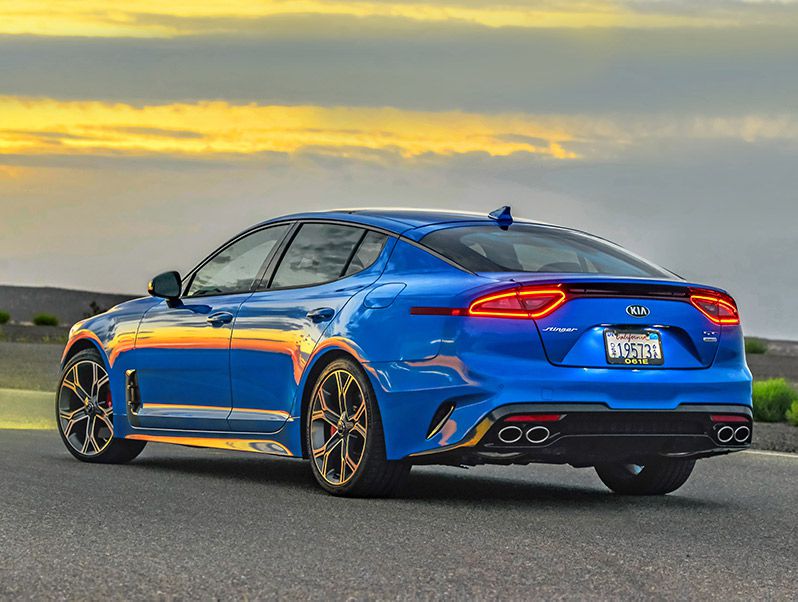
Photo by Kia
Impressive Handling
Kia’s Stinger continues to impress us with its handling. The sedan’s chassis features an independent rear suspension, a limited-slip differential, adjustable shocks, and 19-inch wheels wrapped in wide Michelin Pilot Sport 4 Summer Performance tires, and it strikes a near-perfect balance between luxury and sport. The Stinger feels small from behind the wheel — it’s fast and engaging to drive, but it also delivers a compliant ride.
Its steering is light, communicative, and precise, and its massive Brembo brakes, which are dressed with red calipers, provide good feel and awesome stopping ability. It’s a bit better balanced with the lighter four-cylinder engine instead of the V6, but the Stinger GT changes direction willingly and its front tires offer plenty of grip. Carve up a twisty mountain road and its suspension stays flat, and mid-corner bumps are soaked up well. Kia’s Drive Mode system allows you to tune the sedan to your mood and conditions. There are five driving modes, including Eco, Sport, and Comfort. Each tweaks the throttle response, transmission performance, and steering effort.

Photo by Kia
Many Advanced Safety Systems
Further advanced technology is found in the Stinger’s many important active and passive safety systems. Every Stinger comes standard with blind-spot monitoring with a rear cross-traffic alert, while GT1 models add a forward-collision warning, forward automatic emergency braking with pedestrian detection, smart cruise control with stop-and-go capability, a lane-departure warning, lane-keep assist, and a driver attention warning.
The GT2 adds a 360-degree surround-view parking camera, along with a head-up display that projects the vehicle’s speed and other information on the windshield ahead of the driver. The National Traffic Safety Administration has given the Stinger a five-star safety rating, and the Insurance Institute for Highway Safety has named it a Top Safety Pick.
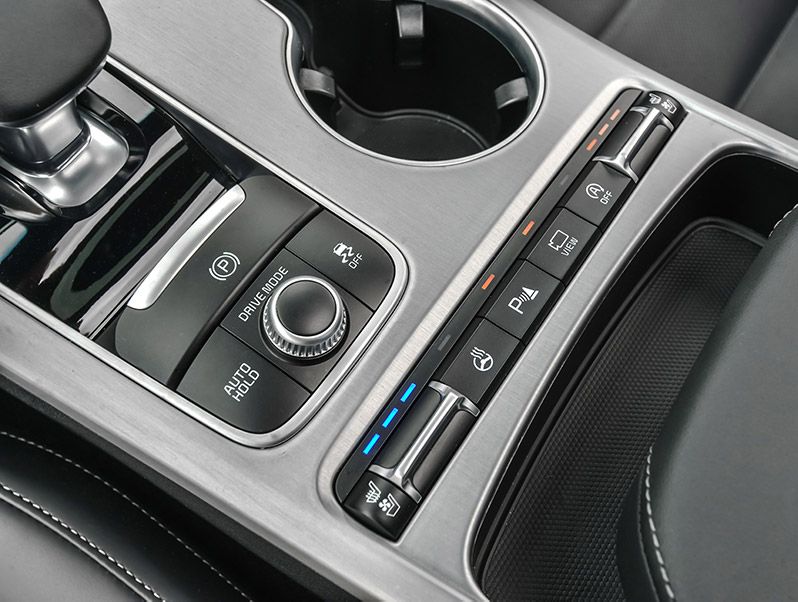
Photo by Kia
Final Thoughts
If you’re looking for understatement, the 2020 Kia Stinger probably isn’t for you. It isn’t overly festooned with too many scoops and flares, but it is sleek with a low, long, and wide stance that turns heads. Its sharkish nose, four huge exhaust pipes, red Brembo brake calipers, and 19-inch wheels speak of intent. Even our neighbor with a new Mercedes S-Class noticed it. “What is it?” he asked. “Looks pretty cool.”
After a week spent driving the Stinger in a multitude of conditions, we still can’t figure out why more folks aren’t buying this car. It delivers a wonderful mix of space, pace, and design; it’s a blast to drive; it’s comfortable; and it looks cool, inside and out. The 2020 Kia Stinger is simply one of the best sedans out there that doesn’t cost an arm and leg.
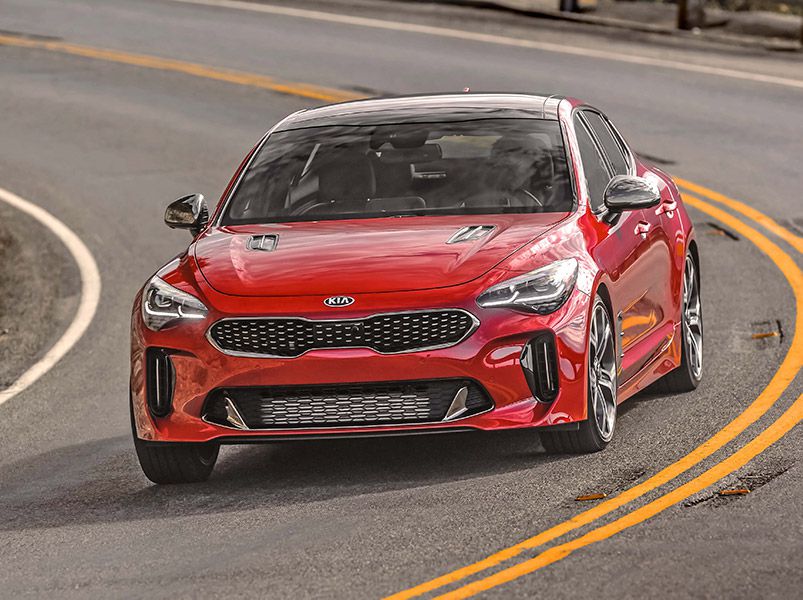
Photo by Kia